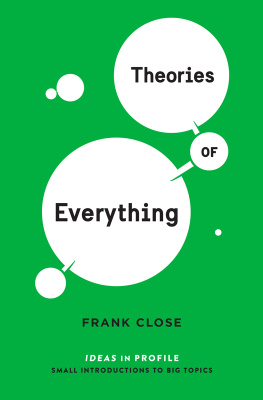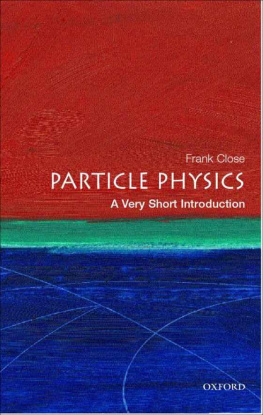THEORIES OF EVERYTHING
FRANK CLOSE is the author of the award winning Half-Life, a biography of Bruno Pontecorvo, Antimatter, The Infinity Puzzle, Very Short Introductions to Nothing and Particle Physics. He is Professor of Physics at Oxford University and a former Head of Communications and Public Education at CERN. In 2014 he was awarded the Michael Faraday Award of the Royal Society for science communication, and is the only scientist to have won an Association of British Science Writers Prize on three occasions.

ALSO BY FRANK CLOSE
An Introduction to Quarks and Partons
End: Cosmic Catastrophe and the Fate of the Universe
Too Hot to Handle: The Story of the Race for Cold Fusion
Lucifers Legacy: The Meaning of Asymmetry
Particle Physics: A Very Short Introduction
Nuclear Physics: A Very Short Introduction
The Particle Odyssey: A Journey to the Heart of the Matter
The New Cosmic Onion: Quarks and the Nature of the Universe
The Void
Neutrino
Antimatter
The Infinity Puzzle
Half Life: The Divided Life of Bruno Pontecorvo, Physicist or Spy
Theories of Everything
FRANK CLOSE

First published in Great Britain in 2017 by
PROFILE BOOKS LTD
3 Holford Yard
Bevin Way
London WC1X 9HD
www.profilebooks.com
Copyright Frank Close 2017
The moral right of the author has been asserted.
All rights reserved. Without limiting the rights under copyright reserved above, no part of this publication may be reproduced, stored or introduced into a retrieval system, or transmitted, in any form or by any means (electronic, mechanical, photocopying, recording or otherwise), without the prior written permission of both the copyright holder and the publisher of this book.
All reasonable efforts have been made to obtain copyright permissions where required. Any omissions and errors of attribution are unintentional and will, if notified in writing to the publisher, be corrected in future printings.
A CIP catalogue record for this book is available from the British Library.
eISBN 978 1 78283 309 3
Index by Bill Johncocks
Lord Kelvins Hubris
In 1980, Stephen Hawking speculated that the end might be in sight for theoretical physics and that the arrival of a Theory of Everything might be imminent. Was he unconsciously echoing the assertion by the American scientist Albert Michelson in 1894 that the grand underlying principles have been firmly established. Further truths of physics are to be looked for in the sixth place of decimals,? Perhaps not.
Nature alone knows what extends beyond the horizons of our present vision, and it repeatedly reveals the limits of our imagination. Within a few years of Lord Kelvins remarks, the discovery of the nuclear atom, and the rise of quantum mechanics and relativity, made the exuberance of those titans of nineteenth-century science appear naive. The truth, however, is more nuanced, and in consequence the implications are rather different. The words of Lord Kelvin (certainly) and Albert Michelson (to a degree) have been taken out of context and often misquoted. When carefully interpreted, what they actually said has a more profound message for seekers of the theory of everything.
Lord Kelvins enduring and strongly held belief that the main role of physics was to measure known quantities to great precision had in fact inspired Michelsons remarks. Lord Kelvin had been impressed by Maxwells theory of electromagnetic radiation as well as by thermodynamics, a description of heat based on mechanics, of which Kelvin himself was a prime architect. It might be possible, he felt, to understand the concept of energy in terms of the motion of particles, as the broad underlying principles seemed to be at hand.
On Friday 27 April, 1900, Kelvin gave a speech about his vision at the Royal Institution in London, the place where Michael Faraday had made the discoveries in the fields of electricity and magnetism that underpinned the new physics. Instead of making an uncritical claim that the synthesis of light, heat and mechanics meant that the end of physics was imminent, Kelvin began his speech thus: The beauty and clearness of the dynamical theory, which asserts heat and light to be modes of motion, is at present obscured by two clouds. This became known as the two clouds speech.
In contrast to the folklore that Lord Kelvin was arrogantly announcing the end of physics, he was actually drawing attention to two outstanding puzzles. If he was wrong, it was in the hope that the two clouds were mere puffs in an otherwise clear blue sky. In reality, they were the heralds of storms. Their removal would require the construction of two great pillars of twentieth-century physics: Einsteins theory of relativity, and the quantum theory.
So Lord Kelvin was wrong in detail, certainly, but he was nonetheless well aware of the limitations of late-nineteenth-century physics. Indeed, when he made those remarks, clues to the impending revolutions in twentieth-century physics were, with hindsight, already in plain view. This will be worth bearing in mind when we come to assess modern claims that the end of physics is once more in sight.
What is a theory of everything, and what is everything?
Theories of everything can be roughly described as theories which draw on work in all relevant branches of current knowledge physics, astronomy, mathematics, and so on which seek to explain everything about the universe that is currently known. From this, it is easy to see that a theory of everything is a moving target. An explanatory account of the known universe may reign supreme for decades, even centuries. During that time it may be the basis for numerous scientific and technological advances. Then, perhaps as a direct or an indirect result of these advances, a new discovery is made, adding to the everything which is known and which cannot be explained by the accepted theory in terms consistent with itself. A new theory of the new everything is then required. And so the cycle continues.
Lord Kelvins two clouds heralded paradigm shifts in our understanding of space and time, and of the microscopic structure of matter. Given that nuclear physics and quantum physics are so rich and far-reaching, and that Albert Einsteins relativity theory absorbed Isaac Newtons great works on mechanics and gravitation, one might wonder how nineteenth-century science could have been blind to them. The explanation of how these fundamental pillars of wisdom remained hidden for so long, while Isaac Newton, James Clerk Maxwell and Lord Kelvin created theories of everything then known, touches on profound properties of our universe, and arguably on our ability to successfully decode its laws.
A theory of everything (or TOE, as it is sometimes abbreviated) would have to describe nature across all distances, times and energies. Our experience is limited to a mere fraction of these vast ranges, though over the centuries it has grown. In practice, nature does not cover the spectrum homogenously, so we can build theories of subsets of phenomena where ignorance in one area need not prevent progress in others.
That we have been able to advance our understanding without having a theory of truly everything is a consequence of the way natural phenomena can be grouped into discrete regimes: they form what I have referred to as a cosmic onion, whose component layers are linked together but whose contents are, to an excellent approximation, independent of one another. A theory of everything-at-one-layer succeeds because nature effectively consigns manifestations of other layers to quarantine. Suitably isolated, they play no effective role in the description of phenomena at the layer of interest.
Next page
















